
- We will send in 10–14 business days.
- Publisher: Language Science Press
- ISBN-10: 3985541280
- ISBN-13: 9783985541287
- Format: 17 x 24.4 x 3.2 cm, cietos vākos
- Language: English
- SAVE -10% with code: EXTRA
The expression of information structure in Bantu (e-book) (used book) | bookbook.eu
Reviews
Description
The Bantu language family is spread over a large area of Africa, stretching from Cameroon to Kenya to South Africa, and comprises an estimated 555 languages. The languages show a large amount of small-scale variation while at the same time forming part of one relatively uniform family within Niger-Congo. Interestingly, the morphosyntax of these languages has been observed to be heavily influenced by information structure. Studying the expression of information structure in Bantu is therefore of great importance not only for developing cognitive models of the role of information structure in language, but also for understanding the basic grammatical structure of the Bantu languages themselves. Before modelling the interaction between syntax and information structure in Bantu, however, a thorough empirical description of the expression of information structure in Bantu should be available. That description is what this book aims to provide. This book follows from a systematic investigation of information structure in the languages of the BaSIS research project (Bantu Syntax and Information Structure). The data come from original field research conducted using the BaSIS methodology, which was specifically developed to investigate the expression of information structure in Bantu. The book contains a comprehensive introduction chapter which explains the main terms and issues in the field of information structure, the methodology employed in the project, and common structures which characterise topic and focus expression in Bantu. The introduction is then followed by eight chapters which each give detailed descriptive overviews of the expression of information structure in a different Bantu language, namely Tunen (Guthrie classification A44, Cameroon), Teke-Kukuya (B77, Congo), Kîîtharaka (E54, Kenya), Kirundi (JD62, Burundi), Rukiga (JE14, Uganda), Kinyakyusa (M31, Tanzania), Makhuwa-Enahara (P31, Mozambique), and Cicopi (S61, Mozambique). Taken together, the book provid
EXTRA 10 % discount with code: EXTRA
The promotion ends in 23d.07:21:51
The discount code is valid when purchasing from 10 €. Discounts do not stack.
- Publisher: Language Science Press
- ISBN-10: 3985541280
- ISBN-13: 9783985541287
- Format: 17 x 24.4 x 3.2 cm, cietos vākos
- Language: English English
The Bantu language family is spread over a large area of Africa, stretching from Cameroon to Kenya to South Africa, and comprises an estimated 555 languages. The languages show a large amount of small-scale variation while at the same time forming part of one relatively uniform family within Niger-Congo. Interestingly, the morphosyntax of these languages has been observed to be heavily influenced by information structure. Studying the expression of information structure in Bantu is therefore of great importance not only for developing cognitive models of the role of information structure in language, but also for understanding the basic grammatical structure of the Bantu languages themselves. Before modelling the interaction between syntax and information structure in Bantu, however, a thorough empirical description of the expression of information structure in Bantu should be available. That description is what this book aims to provide. This book follows from a systematic investigation of information structure in the languages of the BaSIS research project (Bantu Syntax and Information Structure). The data come from original field research conducted using the BaSIS methodology, which was specifically developed to investigate the expression of information structure in Bantu. The book contains a comprehensive introduction chapter which explains the main terms and issues in the field of information structure, the methodology employed in the project, and common structures which characterise topic and focus expression in Bantu. The introduction is then followed by eight chapters which each give detailed descriptive overviews of the expression of information structure in a different Bantu language, namely Tunen (Guthrie classification A44, Cameroon), Teke-Kukuya (B77, Congo), Kîîtharaka (E54, Kenya), Kirundi (JD62, Burundi), Rukiga (JE14, Uganda), Kinyakyusa (M31, Tanzania), Makhuwa-Enahara (P31, Mozambique), and Cicopi (S61, Mozambique). Taken together, the book provid


Reviews